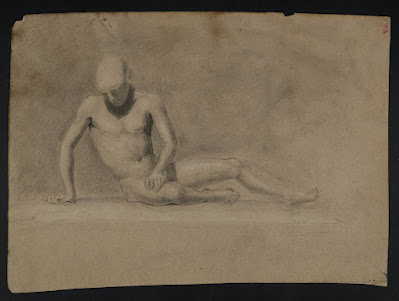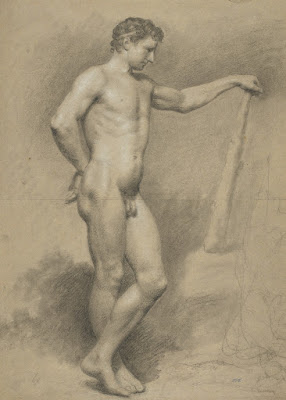 |
| William Blake Pan and Youth (study of a cast of an antique sculpture group) ca. 1785 drawing British Museum |
 |
| William Blake Naked Youth ca. 1779-80 drawing British Museum |
"This drawing was traditionally thought to have been executed when Blake was a student at the Royal Academy in 1779-80. . . . The youth's legs are ultimately derived from the Venus de Medici, while his arms are derived from poses typical of artists of the Italian Renaissance. . . . But Blake went further. He produced a new version of the hermaphrodite, an ideal figure for what he called "the Shape of the Naked" in his Annotations to Sir Joshua Reynolds' Discourses, (c. 1808). A passage in Blake's Annotations throws new light on the drawing: 'I was once looking over the Prints from Rafael & Michael Angelo in the Library of the Royal Academy. Moser (the Keeper) came to me & said: 'You should not study these old Hard, Stiff & Dry, Unfinish'd Works of Art – Stay a little & I will shew you what you should Study.' He went & took down Le Brun's & Rubens's Galleries. How I did secretely Rage! . . . I said to Moser, 'These things that you call Finish'd are not Even Begun: how can they be Finish'd? The Man who does not know The Beginning never can know the End of Art."
 |
| Richard Dalton Apollo Belvedere 1741 drawing Royal Collection, Windsor |
 |
| Joseph Mallord William Turner Study of a cast of the Apollo Belvedere ca. 1792-93 drawing Tate Britain |
 |
| Joseph Mallord William Turner Study of a cast of the Apollo Belvedere ca. 1792 drawing Tate Britain |
 |
| Joseph Mallord William Turner Study of a cast of the Apollo Belvedere ca. 1792 drawing Tate Britain |
 |
| Joseph Mallord William Turner Study of a Model in the Pose of The Dying Gaul ca. 1792 drawing Tate Britain |
 |
| George Romney Study of a Classical Sculpture ca. 1775 drawing Yale Center for British Art |
 |
| Thomas Rowlandson Study of a cast of the Ludovisi Gaul (antique sculpture group also called Paetus and Arria) before 1827 drawing, with watercolor Metropolitan Museum of Art, New York |
 |
| William Mulready Study of a cast of The Wrestlers ca. 1801 drawing Victoria & Albert Museum, London |
"In May 1799 Mulready's parents asked the Royal Academician Thomas Banks to inspect a drawing of the cast of the Apollo, with a view to gaining entry for their son to the Royal Academy Schools. Although Banks did not apparently think Mulready's first effort was up to the required standard, he agreed to assist him on the strength of a second drawing presented to him a month later. For six weeks Mulready attended a drawing school in Furnival's Inn, Holborn, after which he drew from the cast in Banks's studio. He was admitted as a probationer to the Royal Academy in June 1800, and was admitted to the Royal Academy Schools on 23 October 1800. It is not clear whether the date of Mulready's admission was to the Antique Academy or to the Life Schools. Admission to the Schools usually meant that the student was permitted to enter the Antique Academy rather than the Life Schools, for which one had to serve a further apprenticeship. Given Mulready's age, however (he was 14), he was almost certainly admitted to the Antique Academy in October 1800. As Turner spent three years in the Antique Academy, Mulready's drawing made, as the inscription says, to enable him to draw from the living model, may have not been executed until at least 1801."
 |
| Allan Ramsay Reclining Model posed as River God 1755 drawing Scottish National Gallery, Edinburgh |
"One of a series of drawing made in natural light by Ramsay at the French Academy in Rome during his second visit to Italy (1754-1755). Ramsay had first visited the French Academy during his earlier sojourn (1736-1738), where he is recorded as having studied the living model in the evening by lamplight. He continued to draw from the living model on his return to England, at St Martin's Lane, where he was criticised by George Vertue. Critically, Ramsay fared little better on his return to Rome in the 1750s, when Andrew Lumisden told the engraver Robert Strange that Ramsay 'drew such figures as everyone laughed at and wondered how he could pretend to be a painter.' Another fellow-Scot, Robert Adam, also observed in 1756: 'There are many qualities and studies that form a good painter that he is ignorant of as an unborn child, and he for an old boy knows less about the proportions of the human figure than any young boy about Rome, a fact which amazed and astonished me.' Despite criticism, Ramsay continued to draw from the model at the St Martin's Lane Academy. One problem, however, for a busy portraitist like Ramsay must have been that the practice of life drawing was not integrated into his everyday artistic practice. Nonetheless, the drawings which survive from both Ramsay's first and second trips to Italy indicate that the artist rapidly gained in confidence as he drew from the model."
 |
| Allan Ramsay Standing Model posed as Hercules ca. 1758 drawing Scottish National Gallery, Edinburgh |
 |
| James Barry Standing Model posed as Hercules ca. 1777-80 drawing Yale Center for British Art |
"This life drawing is a study for the statue of Hercules which appears in the Crowning of the Victors at Olympia, one of six murals which Barry painted for the Great Room at the Society of Arts between 1777 and 1784. The figure of Hercules, who treads on Envy in the form of a serpent, is located at the extreme left of the painting, and is matched by a statue of the goddess Minerva on the right. . . . It is perhaps no accident that Barry, in a conscious decision to rely on his own creative drive, chose to take as his model a figure based on a life drawing rather than the Farnese Hercules, which would have been the obvious model."
 |
| James Barry Reclining Model posed as Narcissus ca. 1774 drawing British Museum |
 |
| William Pether after Joseph Wright of Derby An Academy (studying a cast of Nymph with a Shell by lamplight) 1772 mezzotint British Museum |
"Joseph Wright exhibited An Academy by Lamplight at the Society of Artists in 1769. William Pether's print was published three years later. The presence of youths rather than men is stressed, perhaps in order to make the point that the study of the antique was the basis of all subsequent artistic education. It is almost certain that Wright's Academy is imaginary, not least because the work is didactic rather than descriptive in its intention to show that the ideal of physical perfection is personified not by the living individual, but by the paradigm offered by the antique."
 |
| Giovanni Battista Cipriani Model posed as Classical Figure pouring a Libation ca. 1760 drawing British Museum |
"Born in Florence, Cipriani had spent the years 1750 to 1753 in Rome, where he had come into close contact with the British artistic community. In 1756 Cipriani went to London, where, in addition to carrying out a number of decorative paintings for William Chambers and Robert Adam, he joined Richard Wilson as an instructor at the Duke of Richmond's Cast Gallery. Cipriani had an abiding interest in art education. He became a member of the St Martin's Lane Academy, and was subsequently a founder member of the Royal Academy, where he was prominent as a teacher."
 |
| Edward Francis Burney Classical Warrior with Sword and Shield ca. 1790-1800 watercolor Yale Center for British Art |
 |
| Edward Francis Burney Classical Warrior Seated ca. 1790-1800 watercolor Yale Center for British Art |
– quoted passages from The Artist's Model: its Role in British Art from Lely to Etty by Ilaria Bignamini and Martin Postle (exhibition catalogue, Nottingham University Art Gallery, 1991)